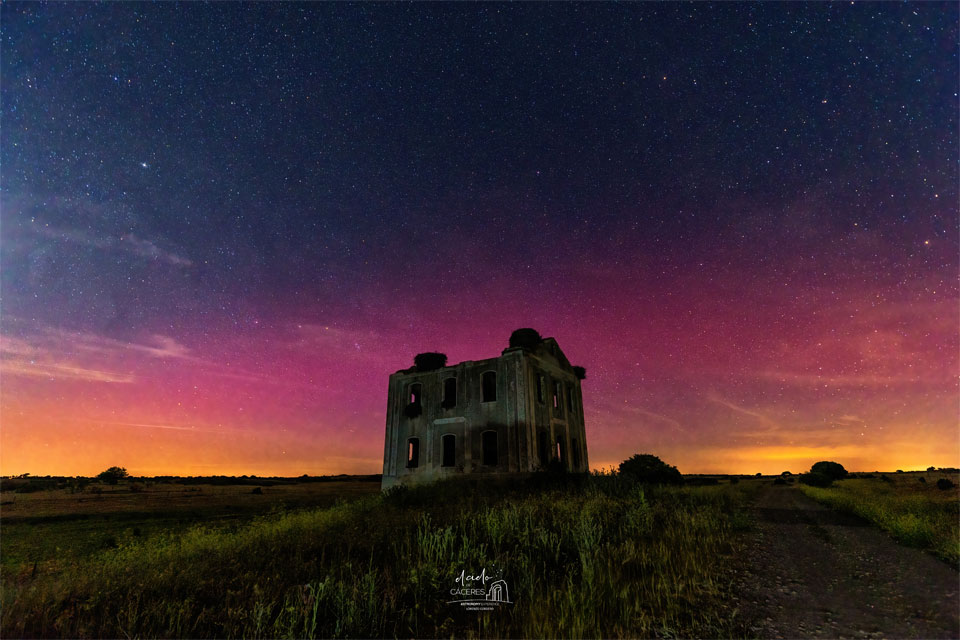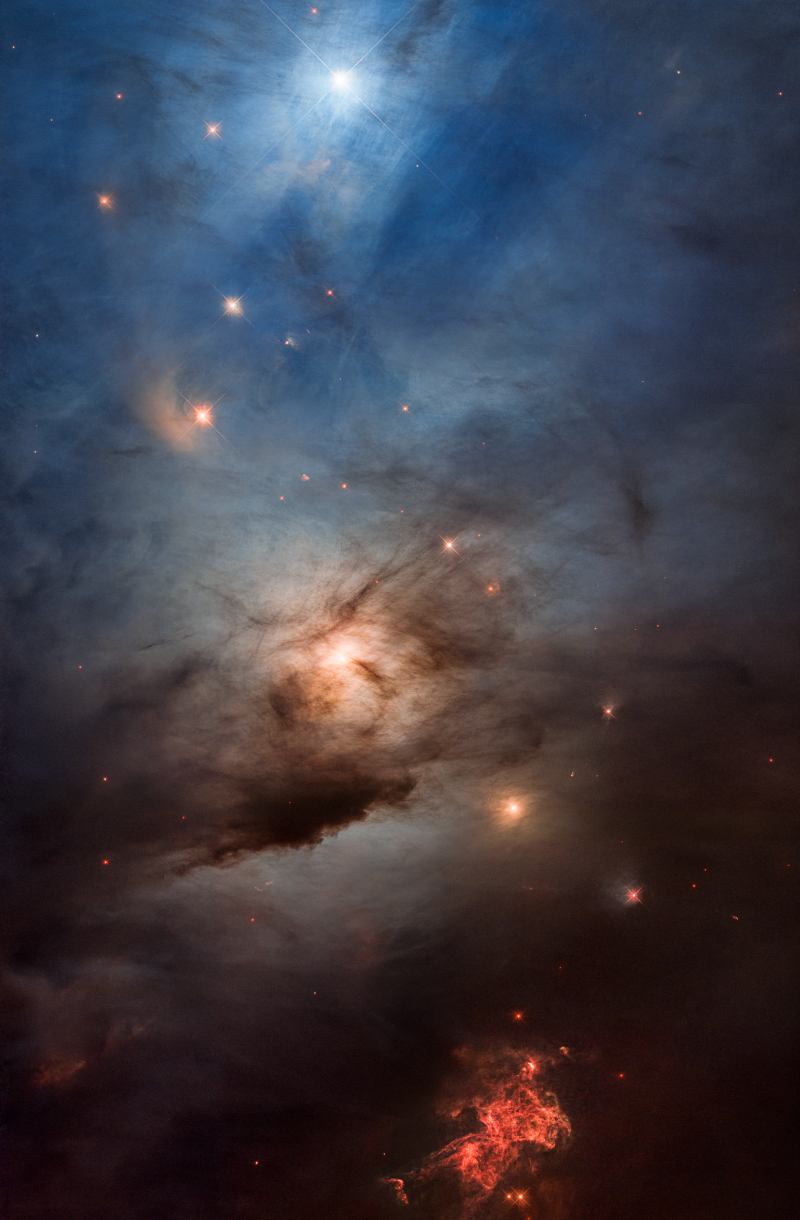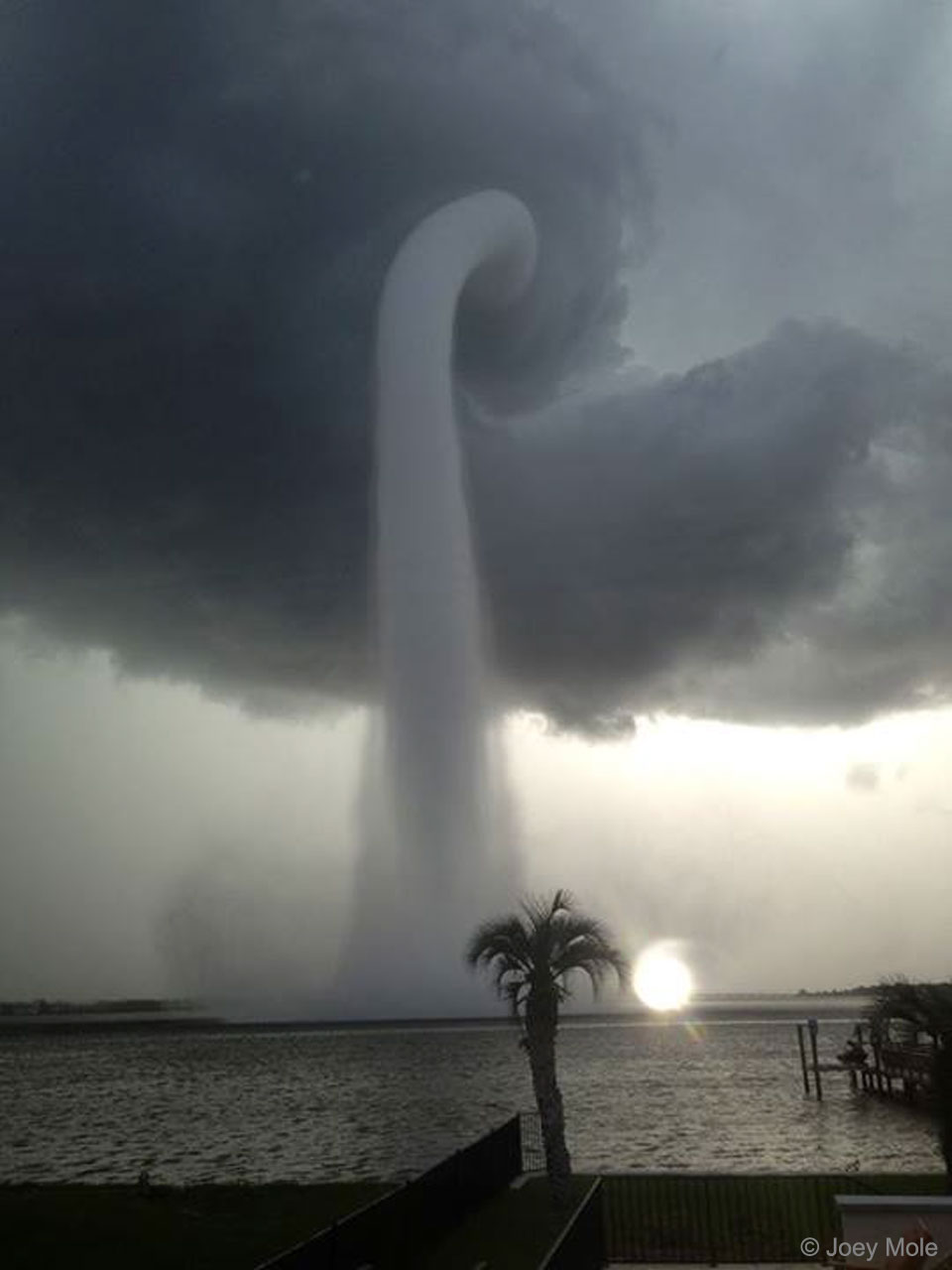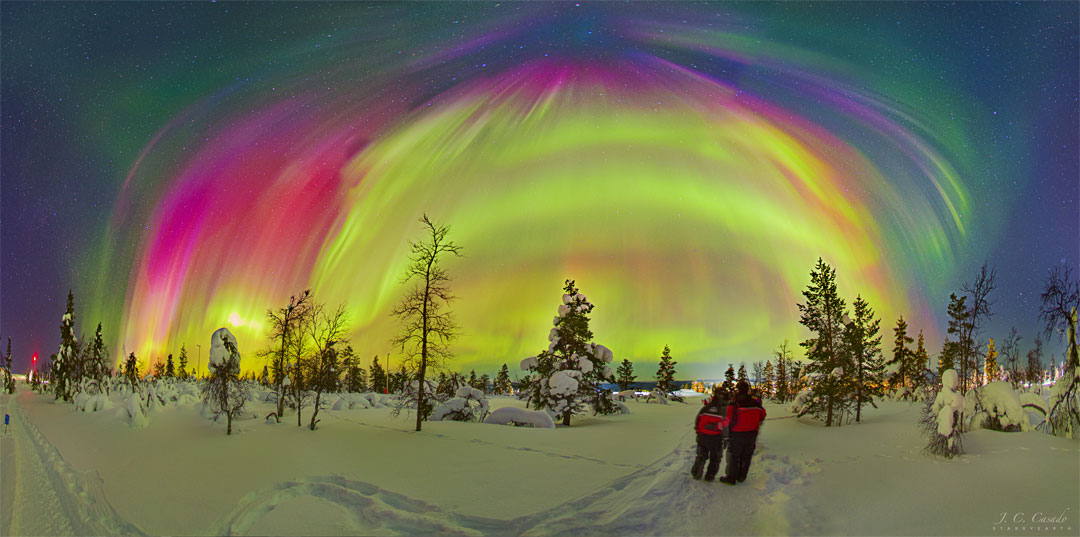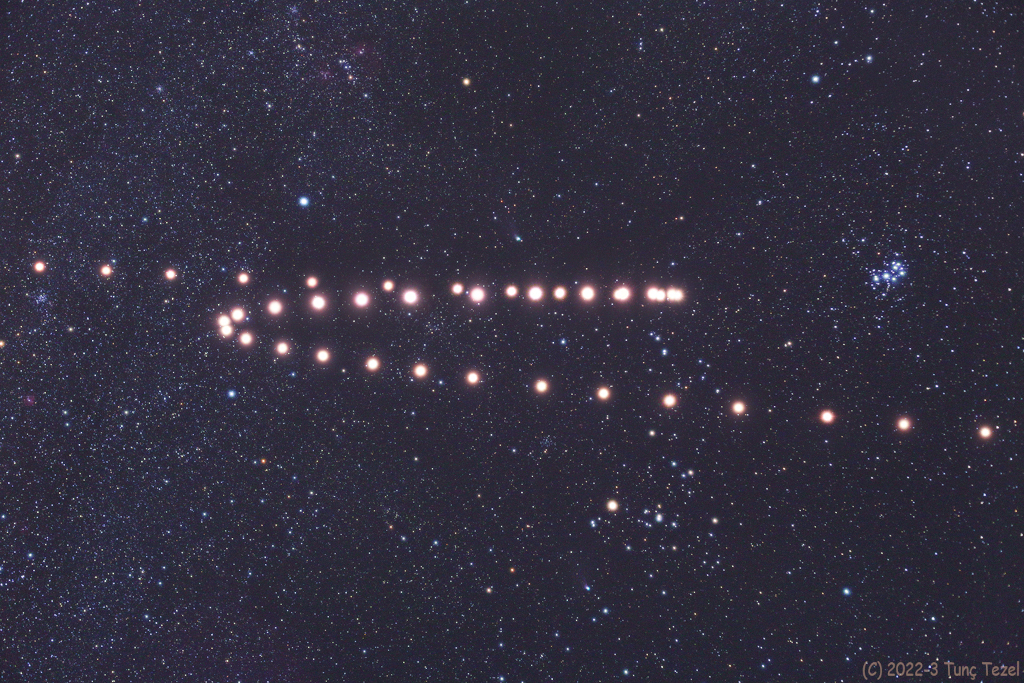
Nombre total de pages vues
26/04/2023
AERONAUTIQUE - Avions de légende - Le Messerschmitt Bf 109, un avion de chasse de référence

ASTRONOMY - The Moon through the Arc de Triomphe
2023 April 26
Image Credit & Copyright: Stefano Zanarello
Explanation: Was this a lucky shot? Although many amazing photographs are taken by someone who just happened to be in the right place at the right time, this image took skill and careful planning. First was the angular scale: if you shoot too close to the famous Arc de Triomphe in Paris, France, the full moon will appear too small. Conversely, if you shoot from too far away, the moon will appear too large and not fit inside the Arc. Second is timing: the Moon only appears centered inside the Arc for small periods of time -- from this distance less than a minute. Other planned features include lighting, relative brightness, height, capturing a good foreground, and digital processing. And yes, there is some luck involved -- for example, the sky must be clear. This time, the planning was successful, bringing two of humanity's most famous icons photographically together for all to enjoy.
25/04/2023
ASTRONOMY - Northern Lights over Southern Europe
2023 April 25
Image Credit & Copyright: Lorenzo Cordero
Explanation: Did you see an aurora over the past two nights? Many people who don't live in Earth's far north did. Reports of aurora came in not only from northern locales in the USA as Alaska, but as far south as Texas and Arizona. A huge auroral oval extended over Europe and Asia, too. Pictured, an impressively red aurora was captured last night near the town of Cáceres in central Spain. Auroras were also reported in parts of southern Spain. The auroras resulted from a strong Coronal Mass Event (CME) that occurred on the Sun a few days ago. Particles from the CME crossed the inner Solar System before colliding with the Earth's magnetosphere. From there, electrons and protons spiraled down the Earth's northern magnetic field lines and collided with oxygen and nitrogen in Earth's atmosphere, causing picturesque auroral glows. Our unusually active Sun may provide future opportunities to see the northern lights in southern skies.
24/04/2023
ASTRONOMY - NGC 1333: Stellar Nursery in Perseus
2023 April 22
Image Credit: Science - NASA, ESA, STScI, Processing - Varun Bajaj (STScI),
Joseph DePasquale (STScI), Jennifer Mack (STScI)
Explanation: In visible light NGC 1333 is seen as a reflection nebula, dominated by bluish hues characteristic of starlight reflected by interstellar dust. A mere 1,000 light-years distant toward the heroic constellation Perseus, it lies at the edge of a large, star-forming molecular cloud. This Hubble Space Telescope close-up frames a region just over 1 light-year wide at the estimated distance of NGC 1333. It shows details of the dusty region along with telltale hints of contrasty red emission from Herbig-Haro objects, jets and shocked glowing gas emanating from recently formed stars. In fact, NGC 1333 contains hundreds of stars less than a million years old, most still hidden from optical telescopes by the pervasive stardust. The chaotic environment may be similar to one in which our own Sun formed over 4.5 billion years ago. Hubble's stunning image of the stellar nursery was released to celebrate the 33rd anniversary of the space telescope's launch.
23/04/2023
ASTRONOMY - A Waterspout in Florida
2023 April 23
Image Credit & Copyright: Joey Mole
Explanation: What's happening over the water? Pictured here is one of the better images yet recorded of a waterspout, a type of tornado that occurs over water. Waterspouts are spinning columns of rising moist air that typically form over warm water. Waterspouts can be as dangerous as tornadoes and can feature wind speeds over 200 kilometers per hour. Some waterspouts form away from thunderstorms and even during relatively fair weather. Waterspouts may be relatively transparent and initially visible only by an unusual pattern they create on the water. The featured image was taken in 2013 July near Tampa Bay, Florida. The Atlantic Ocean off the coast of Florida is arguably the most active area in the world for waterspouts, with hundreds forming each year.
20/04/2023
AERONAUTIQUE - Avions de légende - Le Supermarine Spitfire et son moteur Rolls-Royce
Avec le Messerschmitt Bf 109, le Supermarine Spitfire est l'autre avion de chasse légendaire à s'être illustré durant la seconde guerre mondiale. C'est notamment grâce à lui que la Royal Air Force britannique a pu remporter la célèbre bataille d'Angleterre.
Ce monoplan à ailes elliptiques se caractérise par son profil très aérodynamique qui lui permettait d'atteindre les 650 km/h grâce à son moteur Rolls-Royce. Le Supermarine Spitfire fut produit à plus de 20.300 exemplaires, avec des déclinaisonsutilisées par plusieurs pays, notamment l'Égypte, la France, Israël ou encore la Turquie.
© Jez, CC by-nc 2.0
FuturaSciences
ASTRONOMY - Auroral Storm over Lapland
2023 April 19
Image Credit & Copyright: Juan Carlos Casado (Starry Earth, TWAN)
Explanation: On some nights the sky is the best show in town. On this night, auroras ruled the sky, and the geomagnetic storm that created this colorful sky show originated from an increasingly active Sun. Surprisingly, since the approaching solar CME the day before had missed the Earth, it was not expected that this storm would create auroras. In the foreground, two happily surprised aurora hunters contemplate the amazing and rapidly changing sky. Regardless of forecasts, though, auroras were reported in the night skies of Earth not only in the far north, but as far south as New Mexico, USA. As captured in a wide-angle image above Saariselkä in northern Finnish Lapland, a bright aurora was visible with an unusually high degree of detail, range of colors, and breadth across the sky. The vivid yellow, green, red and purple auroral colors are caused by oxygen and nitrogen atoms high in Earth's atmosphere reacting to incoming electrons.
ART FRACTAL - Intrigante fractale asymétrique

Cette image fractale est complètement asymétrique. Du côté gauche, le fond est sombre et monochromatique alors que du côté droit, plusieurs bandes de couleursvives s'entrecoupent.
© Futura
17/04/2023
ASTRONOMY - M2-9: Wings of a Butterfly Nebula
2023 April 16
Image Credit: Hubble Legacy Archive, NASA, ESA; Processing: Judy Schmidt
Explanation: Are stars better appreciated for their art after they die? Actually, stars usually create their most artistic displays as they die. In the case of low-mass stars like our Sun and M2-9 pictured here, the stars transform themselves from normal stars to white dwarfs by casting off their outer gaseous envelopes. The expended gas frequently forms an impressive display called a planetary nebula that fades gradually over thousands of years. M2-9, a butterfly planetary nebula 2100 light-years away shown in representative colors, has wings that tell a strange but incomplete tale. In the center, two stars orbit inside a gaseous disk 10 times the orbit of Pluto. The expelled envelope of the dying star breaks out from the disk creating the bipolar appearance. Much remains unknown about the physical processes that cause and shape planetary nebulae.
15/04/2023
ASTRONOMY - When Z is for Mars
2023 April 15
Image Credit & Copyright: Tunc Tezel (TWAN)
Explanation: A composite of images captured about a week apart from mid August 2022 through late March 2023, this series traces the retrograde motion of ruddy-colored Mars. Progressing from lower right to upper left Mars makes a Z-shaped path as it wanders past the Pleiades and Hyades star clusters, through the constellation Taurus in planet Earth's night sky. Seen about every two years, Mars doesn't actually reverse the direction of its orbit to trace out the Z-shape though. Instead, the apparent backwards or retrograde motion with respect to the background stars is a reflection of the orbital motion of Earth itself. Retrograde motion can be seen each time Earth overtakes and laps planets orbiting farther from the Sun, the Earth moving more rapidly through its own relatively close-in orbit. High in northern hemisphere skies the Red Planet was opposite the Sun and at its closest and brightest on December 8, near the center of the frame. Seen close to Mars, a popular visitor to the inner Solar System, comet ZTF (C/2022 E3), was also captured on two dates, February 10 and February 16.
ASTRONOMY - Comet C/2025 R2 (SWAN)
2025 September 18 Comet C/2025 R2 (SWAN) Image Credit & Copyright : Team Ciel Austral Explanation: A new visitor from the outer So...

-
2022 September 26 All the Water on Planet Earth Illustration Credit: Jack Cook, Adam Nieman, Woods Hole Oceanographic Institution ; Data ...
-
2024 December 3 Ice Clouds over a Red Planet Image Credit: NASA , JPL-Caltech , Kevin M. Gill ; Processing: Rogelio Bernal Andreo Expla...

